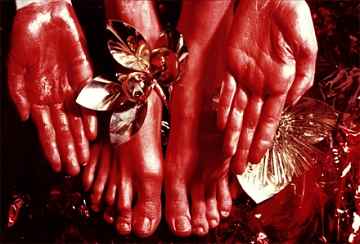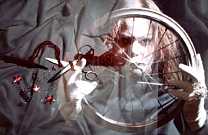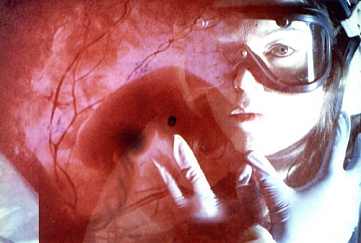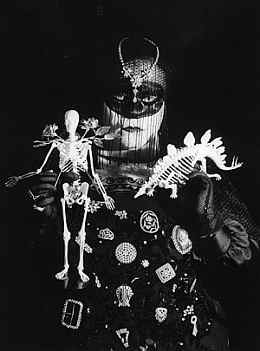|
|||||||
|
|||||||
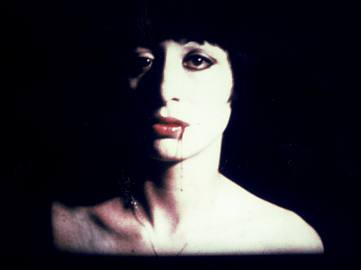 |
|||||||
| THE CREATIVE
PROCESS
Our cinema has often been spoken of as a cinema in rupture. This rupture is situated on several planes, as much on the plane of statement as on that of the creative process. For us, the method of producing images is as significant as the images themselves. Our cinema is marked by our determination to create in independence, far from the constraints and the norms imposed by the industrial cinema. We work together, abolishing specialisations. We appropriate for ourselves all creative functions, at once theoretical, technical and visual. On the level of our personal relationship, it is a political process, being egalitarian, based on dialogue and the autonomy of each, within the framework of a common project. To draw a parallel with writing, our films and film/events
work not so much like novels but more like poems and essays. No fictional
alibi masks the mental experience. The process is action, which is to say,
decision and the moving toward action of the subjects. Imaginative and
conceptual sequence substitutes itself for narrative sequence. The film
becomes a continuum of signifying images, structured according to non-narrative
conceptual schemas. The progression of sequences is defined not by chronological
linearity, but by associative groupings/slips. The fictional persona is
abolished, to the profit of the presence of the subjects, moving through
the films. Identity is not presented through the mediation of a third person,
but enacted by ourselves. We incarnate our mental images, moving toward
a validation of signification by the body. Relationship with language is
thus inscribed within the field of relationship to the body.
To transpose to cinema what Artaud has said of theatre: "there is a mysterious identity of essence between the principle of cinema and that of alchemy. Every true alchemist knows that the alchemical symbol is a mirage, just as cinema is a mirage." In the perpetual spectre which is the projected image, we establish the body, our own bodies, in their materiality. The body is the raw material of our cinema. The body, subject of disguises, transformations and metamorphoses, brings about the transmutation of material into mental, and mental into material. In the space of the body the fusion of abstract and concrete consumes itself, the mental image becomes spatialised thought. It is a "philosophical state of matter", where the unconscious clothes itself in the appearances of the body, the I/within shows itself as I/outside, and the language of the body materialises the language of the unconscious. The elaboration of gesture and posture leads us, of course, to the imaginary. The body, charged with signs, produces at the same time a manifest meaning, a latent meaning, and a hidden meaning. The features which it seizes upon (objects, make-up, jewellery, costumes, gestures, posture), lift up the mask only imperfectly: they hide in unveiling, and reveal by hiding. Artifice is that through which the body becomes inaccessible, that is to say, through which it accedes to the unconscious. The unconscious manifests itself in the closed chamber
of the mind, the silent matrix of the dream, vessel of the alchemical process.
Our films are "chamber films", manifestations of the night: we always shoot
in the same room, always at home, and always at night. Our only venture
outside: the water of a pond at the beginning of L'Enfant qui a pissé
des paillettes. The black background which effaces all environment,
and which we use in our performance works, evokes the interior screen:
that which is found on the other side of the mirror, inside the mind, behind
closed eyelids, and which promotes introspection. The quest of alchemy,
after all, is the journey into the depths of things. ABOUT PROJECTION The room in which we film is the first place where projection, in the analytical sense of the term, is spatialised. The body is the first material screen, where we project the rituals of our desire. It is in that other camera obscura, the cinema hall, that the screen becomes a precise object, and projection a physical act. By handling the projectors ourselves, we create a mirror effect between projecting and projected bodies. By our presence in the room, we give a physical quality to the cinematic apparatus, demythifying the technological process which presupposes the absence, the physical effacement ot the film-makers. In addition, the putting of the film into a box, its reduction to the status of object, following the norms of traditional projection, is radically cancelled by the significant integration of other media: video, slides, live sound through a microphone; above all the slide, the fixed image, which has a very important place in our film/performances: it is the instant, suddenly caught in the trap of duration. The expanded screen in L'Enfant qui a pissé
des paillettes, the exploded screen in Soma, the pultiple screen
in Arteria Magna, the white screen, emptied of images, and refilmed,
in Unheimlich I: Dialogue secret, the black screen in Astarti,
the broken, torn screen in Ouverture are so many devices for the
explosion of projection, both mental and cinematic. First published in Canal No. 35-36, Paris, January 1980 Translated by David Templer
|
|||||||
|
|||||||
|
|||||||
